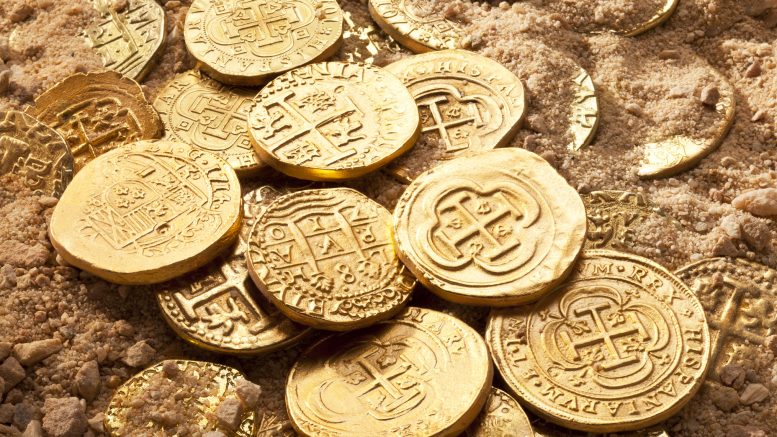Gold is still being discovered in England, but it’s not geologists doing the finding. As we emerge from the pandemic it seems that many of us spent the lockdown digging up treasure.
England enjoyed its ‘Freedom Day’ on July 19, when almost all lockdown restrictions were lifted. Despite a recent rise in cases of Covid-19, people are no longer advised to work at home, masks are not obligatory, and nightclubs and sporting events can function at full capacity. Relaxation of the restrictions has been more cautious, however, in other parts of the U.K. — Scotland, Wales and Northern Ireland.
Since the first lockdown measures were announced in March 2020 there has been a marked increase in the time spent on hobbies, not least gardening and metal detecting. Gold is being dug up as a result. We know this because since 1996 there has been a legal requirement to report all discoveries of treasure — essentially single finds of gold and silver over 300 years old, and hoards of coins and prehistoric metalwork.
In 1997, the British Museum established the Portable Antiquities Scheme (PAS) in response to the growth of metal detecting, the lack of provision to record these finds, and a change in legislation to provide protection for archaeological finds.
Discoveries documented by PAS have just passed 1.5 million items, and range from prehistoric-worked flint to post-medieval dress accessories. The documented items include almost 753,000 coins, 58,000 brooches, 56,000 rings and 18,000 swords (although only 270 have gold on the pommel).
PAS documented the discovery of 47,000 artifacts in 2020, and gardens seem to be the place to look for treasure. In August last year, for example, a metal detectorist unearthed a hoard of over 1,000 silver coins dating back to the 15th century in the garden of his local pub. Experts surmised that the money was hidden by a wealthy landowner who was called up to fight during the English Civil War (one assumes he didn’t make it back, and neglected to tell anyone where his money was hidden).
In December, a rather more modern hoard of 50 South African Krugerrand was found, by chance, in a garden in Milton Keynes. Each coin is worth up to US$2,000.
Also in December, a family in Hampshire were weeding their garden when they uncovered 63 gold coins from the 15th and 16th centuries. These included four rare coins from Henry VIII’s reign, which bear the initials of three of his wives (Catherine of Aragon, Anne Boleyn and Jane Seymour).
The coins were likely buried in about 1540, while King Henry VIII was still alive, but the circumstances are unknown. Whoever hid the coins, however, was a person of means, as the collection was worth about £24 at the time (much more than the average annual wage during Tudor times), which is today the equivalent of £14,000 (US$19,400). Experts suggest it was likely to be a member of the clergy as the monasteries were being dissolved by Henry VIII during this period after his spat with Rome over plans to divorce Catherine.
The value of such finds was demonstrated at an auction in London last month of a coin issued from the Tower of London by Henry VIII between 1538 and 1541. The 22-carat sovereign (the origin of the modern pound coin) weighs 15.3 grams and sold for £64,500 (US$90,000).
Globally, there is much more gold still to find. The first gold coin was minted by King Croesus of Lydia (modern day Turkey) in the 6th century B.C., and it is estimated that some 200,000 tonnes (over 6,400 million ounces) of gold has been mined globally.
People tend to remember what they’ve done with their gold, and we can account for an impressive 94% of the gold ever extracted (this includes gold in jewellery, bars and coins, and Central Bank holdings). Nevertheless, that leaves some 12,000 tonnes (nearly 386 million ounces) that is lost or hidden — relatively little is thought to have been destroyed.
Much of this gold, worth US$700 billion at the current gold price, will be under the waves. In the U.K. there are over 1,000 documented shipwrecks on the treacherous Goodwin Sands (off the coast of Kent) alone. To the west, treasure hunters are narrowing down the search for what is believed to be our most valuable shipwreck, the Merchant Royal. This ship sank off the coast of Cornwall after hitting bad weather in 1641, and is reported to contain gold and silver worth more than US$1.5 billion.
The past 18 months have been challenging for us all, but the gloom will have been lifted for those who found buried treasure. Here in England it is a good enough reason to dig deep when weeding the garden.
— Dr. Chris Hinde is a mining engineer and the director of Pick and Pen Ltd., a U.K.-based consulting firm he set up in 2018 specializing in mining industry trends. He previously worked for S&P Global Market Intelligence’s Metals and Mining division.


Be the first to comment on "The View from England: Pandemic yields buried treasure"